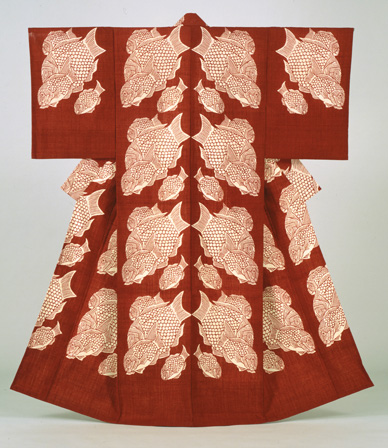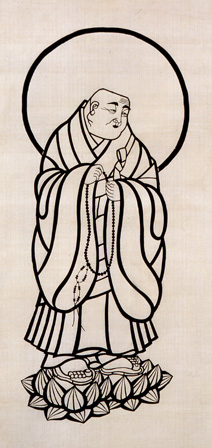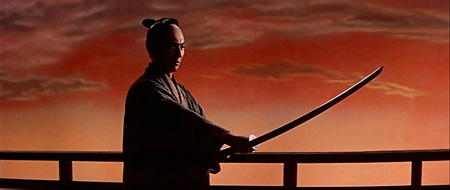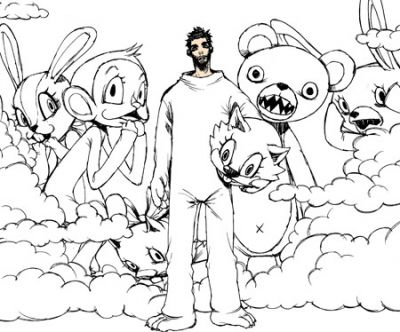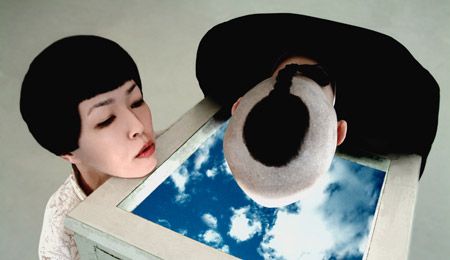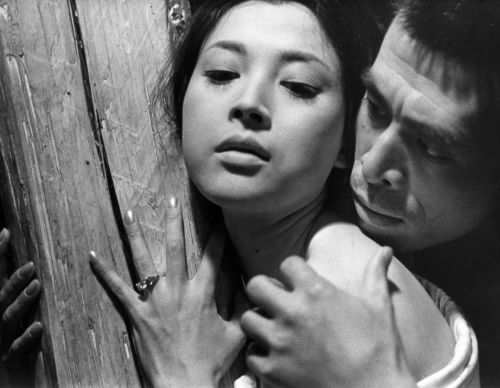
Mariko Okada shows off her discreet charm in Yoshishige Yoshida’s steamy tale THE AFFAIR (© Shochiku Co., Ltd.)
THE AFFAIR (JOEN) (FLAMES OF LOVE) (Yoshishige Yoshida, 1967)
Japan Society
333 East 47th St. at First Ave.
Thursday, April 15, 7:30
212-715-1258
www.japansociety.org
 “Mariko Okada: The Discreet Charm of the Adulteress,” the final section of the Japan Society’s three-part “Mad, Bad . . . & Dangerous to Know: Three Untamed Beauties” film series, begins on April 13 with a screening of Yoshishige Yoshida’s fifth collaboration with Okada and continues on April 14 with the fascinating erotic tale THE AFFAIR. In the latter, also known as FLAMES OF LOVE, Okada stars as Oriko, an unhappily married woman who wants a divorce from her cheating husband, Furuhata (Tadahiko Sugano). In a flashback, she shows her displeasure with her widowed mother (Yoshie Minami), who is carrying on a heated affair with young sculptor Mitsuhuru (Isao Kimura); in the current day, she seeks out the Noguchi-like artist to find out about his relationship with her now-dead mother but learns a lot more than she expected. Meanwhile, Furuhata’s sister, Yokio (Shigako Shimegi), tries to get the traditional, old-fashioned Oriko out of the house and partying with her three male friends, who smoke cigarettes, drink beer, and break out in sudden groovy dances at the spur of the moment. But when Oriko—who still wears kimonos and worries about what is considered proper in a society that is changing drastically all around her—spies on Yokio having hot, casual sex with a common worker (KILL!’s Etsushi Takahashi in his film debut), her own hidden sexuality is awakened. Yoshida, who trained at Shochiku under Nagisa Oshima (CREUL STORY OF YOUTH, IN THE REALM OF THE SENSES), incorporates Bergmanesque touches with a Nouvelle Vague sensibility and more than a hint of Teshigahara (WOMAN IN THE DUNES) in this strikingly visual, highly stylized tale, including sweeping, dreamlike flashbacks, gorgeous long shots, and a haunting theme of duality evident in his use of mirrors and windows, light and dark. “Mad, Bad . . . & Dangerous to Know” concludes on April 18 with Yoshida’s WOMAN OF THE LAKE (ONNA NO MIZUUMI) and Yasuzo Masumura’s highly charged TWO WIVES (TSUMA FUTARI), which has never before been screened outside of Japan.
“Mariko Okada: The Discreet Charm of the Adulteress,” the final section of the Japan Society’s three-part “Mad, Bad . . . & Dangerous to Know: Three Untamed Beauties” film series, begins on April 13 with a screening of Yoshishige Yoshida’s fifth collaboration with Okada and continues on April 14 with the fascinating erotic tale THE AFFAIR. In the latter, also known as FLAMES OF LOVE, Okada stars as Oriko, an unhappily married woman who wants a divorce from her cheating husband, Furuhata (Tadahiko Sugano). In a flashback, she shows her displeasure with her widowed mother (Yoshie Minami), who is carrying on a heated affair with young sculptor Mitsuhuru (Isao Kimura); in the current day, she seeks out the Noguchi-like artist to find out about his relationship with her now-dead mother but learns a lot more than she expected. Meanwhile, Furuhata’s sister, Yokio (Shigako Shimegi), tries to get the traditional, old-fashioned Oriko out of the house and partying with her three male friends, who smoke cigarettes, drink beer, and break out in sudden groovy dances at the spur of the moment. But when Oriko—who still wears kimonos and worries about what is considered proper in a society that is changing drastically all around her—spies on Yokio having hot, casual sex with a common worker (KILL!’s Etsushi Takahashi in his film debut), her own hidden sexuality is awakened. Yoshida, who trained at Shochiku under Nagisa Oshima (CREUL STORY OF YOUTH, IN THE REALM OF THE SENSES), incorporates Bergmanesque touches with a Nouvelle Vague sensibility and more than a hint of Teshigahara (WOMAN IN THE DUNES) in this strikingly visual, highly stylized tale, including sweeping, dreamlike flashbacks, gorgeous long shots, and a haunting theme of duality evident in his use of mirrors and windows, light and dark. “Mad, Bad . . . & Dangerous to Know” concludes on April 18 with Yoshida’s WOMAN OF THE LAKE (ONNA NO MIZUUMI) and Yasuzo Masumura’s highly charged TWO WIVES (TSUMA FUTARI), which has never before been screened outside of Japan.

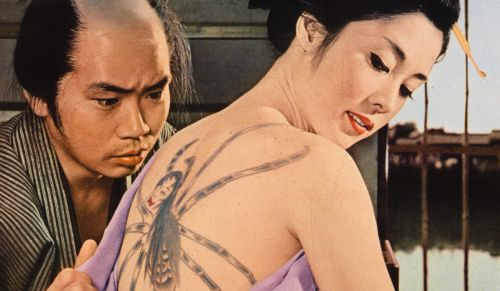
 Adapted from a short story by Junichirô Tanizaki, IREZUMI, the opening-night selection of the Japan Society’s “Mad, Bad . . . & Dangerous to Know” series, was one of the first Japanese exploitation films shot in color. Ayako Wakao stars as Otsuya, a pawnbroker’s daughter who aches to get away from her boring life. She convinces her father’s apprentice, the meek Shinsuke (Akio Hasegawa), to steal the shop’s money and run away with her, but the plan goes awry when she is sold into sexual slavery to Tokubei (Asao Uchida). Enraptured by her skin, Seikichi (Gaku Yamamoto) marks her for Tokubei by tattooing a huge spider across her back, promising it will bring her special power over men. Soon Otsuya is exacting bloody revenge with the help of the poor, misguided Shinsuke. Directed by Yasuzo Masumura, who also worked with Wakao on such films as MANJI and RED ANGEL (which screens April 1), IREZUMI is a dark, compelling tale that is not afraid to break out of genre conventions. The screening will be followed by the Dressed to Kill! party, where attendees are encouraged to come in costume as their favorite cinematic femme fatale.
Adapted from a short story by Junichirô Tanizaki, IREZUMI, the opening-night selection of the Japan Society’s “Mad, Bad . . . & Dangerous to Know” series, was one of the first Japanese exploitation films shot in color. Ayako Wakao stars as Otsuya, a pawnbroker’s daughter who aches to get away from her boring life. She convinces her father’s apprentice, the meek Shinsuke (Akio Hasegawa), to steal the shop’s money and run away with her, but the plan goes awry when she is sold into sexual slavery to Tokubei (Asao Uchida). Enraptured by her skin, Seikichi (Gaku Yamamoto) marks her for Tokubei by tattooing a huge spider across her back, promising it will bring her special power over men. Soon Otsuya is exacting bloody revenge with the help of the poor, misguided Shinsuke. Directed by Yasuzo Masumura, who also worked with Wakao on such films as MANJI and RED ANGEL (which screens April 1), IREZUMI is a dark, compelling tale that is not afraid to break out of genre conventions. The screening will be followed by the Dressed to Kill! party, where attendees are encouraged to come in costume as their favorite cinematic femme fatale.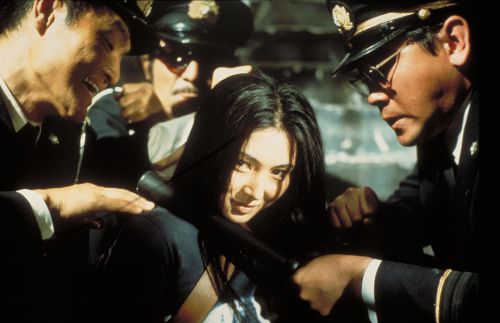
 A cult classic that spawned three sequels, Shunya Ito’s highly stylized SCORPION has everything a women-in-prison flick needs: sex, torture, rape, lesbianism, riots, sadistic male guards, shower scenes, gory violence, and lots and lots of unnecessary nudity. Set up by corrupt cop Sugimi (Isao Natsuyagi), to whom she gave her virginity, young and innocent Nami Matsushima (Meiko Kaji) is sent up the river, where she refuses to say anything about her case, leading to constant brutalization, including a harrowing hole-digging scene and some hog-tying. Afraid that she might eventually talk, Sugimi enlists another inmate, Katagiri (Rie Yokoyama), to kill her, but Matsu is not about to let anyone get in the way of her plan for revenge. Solid sexploitation all the way, SCORPION lays out much of the groundwork for Quentin Tartantino’s KILL BILL flicks; in fact, he even used the film’s theme song, “Urami-Bushi” (“Her Song of Vengeance”), which is sung by Kaji. Kaji went on to make several more FEMALE PRISONER SCORPION films with Ito and played Lady Snowblood in two movies directed by Toshiya Fujita, both of which are also part of the “Meiko Kaji: A Mad, Bad Unholy Easter Weekend” section of the Japan Society’s “Mad, Bad . . . & Dangerous to Know” film series.
A cult classic that spawned three sequels, Shunya Ito’s highly stylized SCORPION has everything a women-in-prison flick needs: sex, torture, rape, lesbianism, riots, sadistic male guards, shower scenes, gory violence, and lots and lots of unnecessary nudity. Set up by corrupt cop Sugimi (Isao Natsuyagi), to whom she gave her virginity, young and innocent Nami Matsushima (Meiko Kaji) is sent up the river, where she refuses to say anything about her case, leading to constant brutalization, including a harrowing hole-digging scene and some hog-tying. Afraid that she might eventually talk, Sugimi enlists another inmate, Katagiri (Rie Yokoyama), to kill her, but Matsu is not about to let anyone get in the way of her plan for revenge. Solid sexploitation all the way, SCORPION lays out much of the groundwork for Quentin Tartantino’s KILL BILL flicks; in fact, he even used the film’s theme song, “Urami-Bushi” (“Her Song of Vengeance”), which is sung by Kaji. Kaji went on to make several more FEMALE PRISONER SCORPION films with Ito and played Lady Snowblood in two movies directed by Toshiya Fujita, both of which are also part of the “Meiko Kaji: A Mad, Bad Unholy Easter Weekend” section of the Japan Society’s “Mad, Bad . . . & Dangerous to Know” film series.